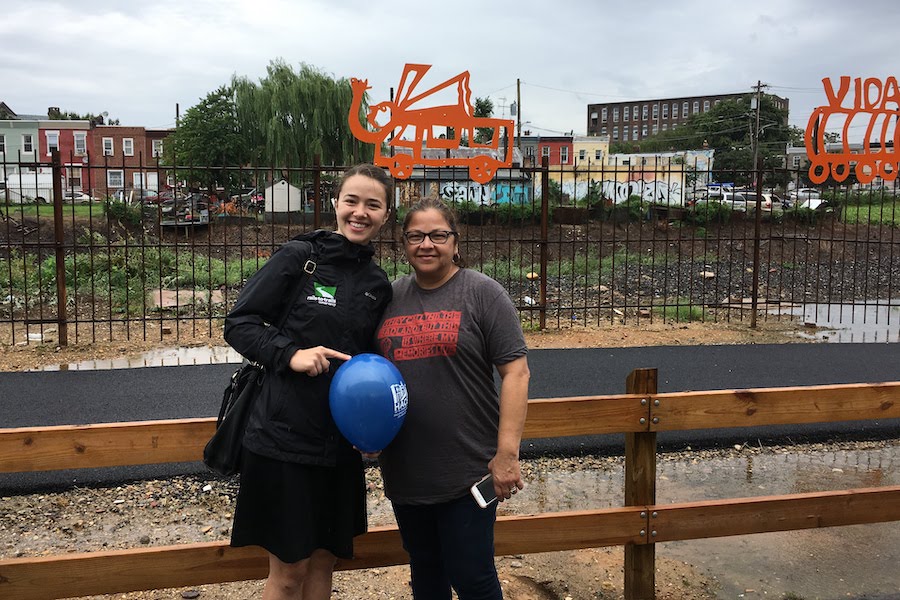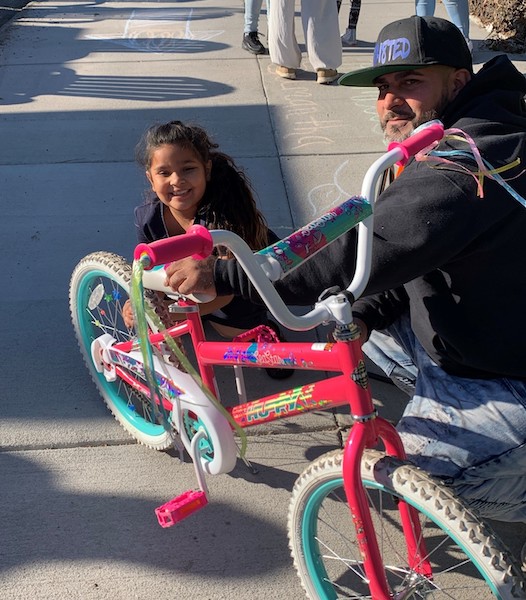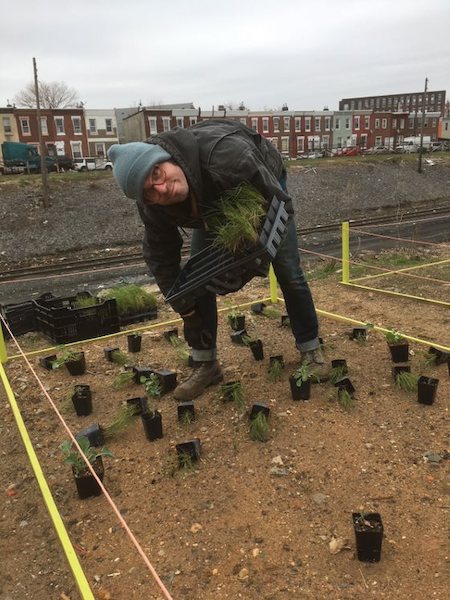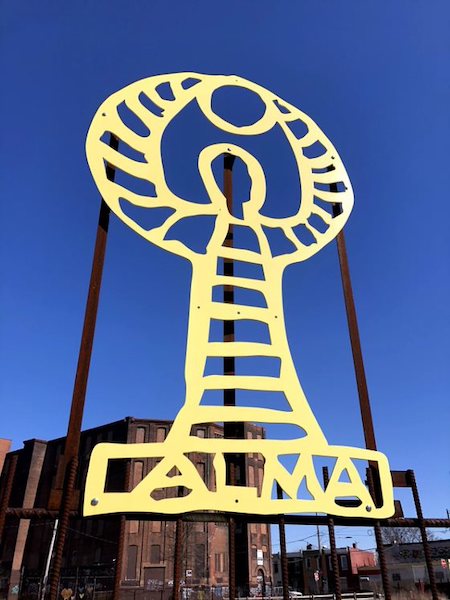Richmond Industrial Trail
Gurney Street Trail pilot project along the planned Richmond Industrial Trail | Photo courtesy HACE
Vision and Opportunity
The Richmond Industrial Trail is a developing, 1.8-mile walking and biking greenway trail that will connect five communities to the Delaware River, green space, public transportation options, anchor institutions and multiple developing community development projects along the corridor. When complete, this unique rail-with-trail will serve as a local hub for access to regional transportation and recreation networks throughout Philadelphia and the greater metropolitan area, including the Circuit Trails, a developing 800-mile world-class network of rail-trails in Greater Philadelphia and Camden, New Jersey.
Less than 3 miles north of Center City Philadelphia, the Richmond Industrial Track is a corridor that has historically created both opportunities and challenges for communities adjacent to the line. Its route crosses the neighborhoods of Fairhill, Kensington, East Kensington, Olde Richmond and Port Richmond as it transitions from the elevated Lehigh Viaduct to a section known as “the cut,” which runs below grade. Once the most active freight line in the city, the Richmond Industrial Track was key in supporting the region’s economic growth from the late 1800s to the mid-1900s. More recently, the corridor is envisioned in over 12 plans as a multi-use trail with the potential to serve more than 40,000 residents living within a half-mile of the corridor. The project would provide a safe biking and walking route appropriate for all ages and abilities, where, currently, unprotected bicycling facilities and substandard or missing sidewalks are common.
Why Build the Richmond Industrial Trail: Making the Case

Supporting Healthy Communities
The public health and wellbeing benefits the trail will bring to adjacent neighborhoods and the broader community are significant. The rail-with-trail will allow for low-cost or no-cost opportunities for exercise by providing safe outdoor spaces to be active outdoors in an area where few safe sidewalks, biking facilities and parks exist. With limited options for safe physical activity, currently the rates of obesity in the area are at 37%, and 40% of residents do not exercise, according to the Centers for Disease Control and Prevention. These rates are 6% and 10% higher than the city averages, respectively, and 8% and 14% higher than national rates. Data shows that having a trail close to home increases the physical activity of residents by 22%.
Strengthening Local Economies
Communities which support active living and access to trails provide direct access between residents and nearby businesses – strengthening ties between neighbors and business, and providing safe, healthy ways to shop, work and play while socially distancing and staying close to home. Like many trails across the country, the Richmond Industrial Trail will encourage businesses to locate along the corridor because of the increased foot and bike traffic the trail will bring. Additionally, the forthcoming HACE Trail Park will provide opportunities for small businesses to cater to those enjoying the park as well as the robust programming that is planned for the site. The trail will serve as a major attraction and is expected to draw visitors from across the city, which will provide additional customers to new and existing business along the corridor.

Promoting Equitable Investments in our Neighborhoods
Investing in the Richmond Industrial Trail is an investment in neighborhoods that have been underserved and underinvested in for too long. In Philadelphia, as in many cities across America, not every neighborhood has received the same level of investment in transportation, recreation, public health and quality of life. Infrastructure such as urban trails and green space, which turn barriers in the built environment into community nodes and connecting corridors, create direct high return investments in the quality of life, wellbeing and access to opportunity for residents adjacent to this former industrial corridor.
Connecting the Dots through Active Transportation and Community Greenspace
From HACE’s innovative Trail Park on one end, to the exciting work being planned for DRWC’s Graffiti Pier on the other, there are many inspiring projects being developed along the Richmond Industrial Trail. The trail promises to link these and other initiatives together through a rail-trail serving as the backbone of an incredible linear park, stretching nearly 2 miles.
The disjointed sidewalks and inadequate bike lanes along the corridor currently make walking and bicycling hazardous. The new trail will provide safe active-transportation infrastructure for residents of all ages and abilities, opening up new opportunities for access to destinations across the corridor’s five neighborhoods without reliance on a car. Additionally, strong regional connections, including to the Circuit Trails network and the 3,000-mile East Coast Greenway, will provide access to major parks, recreational amenities and the Delaware River waterfront.

Preserving the Environment
By preserving this formerly industrial corridor as public open space, a new nearly 2-mile long ribbon of meadow, forest and gardens could be introduced to north Philadelphia, creating opportunities to increase the city’s tree canopy, treat storm water through rain gardens and native habitat installations. These opportunities for greening can support pockets of wildlife habitat in the heart of the city and improve air quality, provide access to nature for area residents, and provide pollinator habitats by rebuilding and restoring regenerative ecosystems along the corridor – providing safe havens for respite, and restoration for both people and wildlife. Additionally, by providing safe walking and biking options, residents will rely less on cars, preventing greenhouse gas emissions.
Preserving Local History
A reminder of Philadelphia’s industrial heritage that supported the nation’s growth, the physical infrastructure of the corridor serves as an impressive monument to Philadelphia’s place in railroad, industry, manufacturing, and transportation history of the region and beyond. Preserving this corridor will enable the surrounding communities to use the trail to tell their parts of that story, and the larger story of Philadelphia and the region as a whole.

How It’s Getting Done

Rails-to-Trails Conservancy has worked closely with local partners to move the Richmond Industrial Trail project forward, taking it from concept to a developing reality. Below are the steps the coalition has taken to build support and advance the rail-with-trail initiative in North Philadelphia:
Exploring the Concept
In 2018, Rails-to-Trails Conservancy (RTC) and local partners explored the concept of a trail and completed an initial study of the Richmond Industrial Track, which analyzed previous planning efforts and transportation corridors within the focus area. Working closely with a collection of community-level stakeholders, RTC made a series of recommendations for advancing a trail along a 1.87-mile corridor between Richmond and American streets and connecting key neighborhoods and community assets to larger nearby trail and transportation systems.
Completing a Feasibility Study
RTC and partners then completed a formal feasibility study, which found that a trail system built along the corridor could connect five neighborhoods while improving the local economy and benefiting public health and safety in the process. The study outlines next steps for making this trail a reality for both the city and the neighborhoods along the corridor.
This study was done with collaboration and input from the following local partners:
- Bicycle Coalition of Greater Philadelphia
- Conrail
- Delaware River Waterfront Corporation (DRWC)
- Delaware Valley Regional Planning Commission (DVRPC)
- Hispanic Association of Contractors & Enterprises (HACE)
- Impact Services Corporation
- New Kensington Community Development Corporation (NKCDC)
- Office of Councilman Mark Squilla
- Office of Councilwoman Maria Quiñones Sánchez
- Philadelphia City Planning Commission (PCPC)
- Philadelphia Water Department (PWD)
- Pennsylvania Environmental Council (PEC)
- Riverfront North Partnership (RNP)
Planning Review and Collaboration
Referenced in over 12 local neighborhood and city plans, the Richmond Industrial Trail is envisioned as a new amenity that would serve more than 40,000 residents living within a half-mile of the corridor.
Building a Coalition and Cultivating Relationships
We’re collaborating with business improvement districts, neighborhood associations, government agencies, real estate developers, community development corporations and the private sector to advance the vision of the Richmond Industrial Trail.
Supporting Early Action Grants in the areas of:
- Moving the Little Gurney Street Trail vision forward through clean up, beautification and partnership engagement
- Beautification and cleaning around the intersection of Aramingo and Lehigh Avenues to build momentum and interest for the Richmond Industrial Trail.
- The “Art Walk”, a community-informed art installation along the corridor by local artist Marta Sanchez
- Community bike festival hosted by Impact Service
- Investigative landscaping pilot project to determine which plants can survive in the adverse soil conditions along the corridor
Providing technical assistance to partner organizations: providing support in areas such as fundraising, grant writing, trail design assistance, community outreach and partner collaborations.
To learn more about the project, explore the Richmond Industrial Trail StoryMap, read the blog, and sign up to receive updates as this project evolves.
This work is being made possible by the following funding sources:
- The William Penn Foundation
- Rails to Trails Conservancy
- HACE
- Coca-Cola Foundation Metropolitan Grants Program
- Pennsylvania American Association of Retired Persons
- Pennsylvania Department of Conservation and Natural Resources, Community Conservation Partnerships Program
- Department of Community and Economic Development Greenways, Trails and Recreation Program
- Impact 100
- Conrail
Additional Resources:
- Graffiti Pier Project: https://www.delawareriverwaterfront.com/planning/projects3/graffiti-pier-park-project
- Gurney Street Trail: https://www.hacecdc.org/projects/gurney-street-trail/
- Philadelphia Trail Master Plan: https://www.phila.gov/media/20201230212117/2020_TrailPlan_Update-12-30-20.pdf
- Goodlands Plan: https://www.hacecdc.org/wp-content/uploads/2019/08/Goodlands-2025-Neighborhood-Plan__rs.pdf
Press:
- Artist Lauren West Helps to Brighten Up a Once Dark Spot in Port Richmond! | Wooder Ice
- Can Graffiti Pier become a tourist attraction and still serve the people who put it on the map? | WHYY PBS
- Philly group gets state grant to transform troubled Fairhill railyard into city park | Philly Voice
- Philly and Conrail to clean up ‘heroin hellscape’ Philadephia Inquirer
- Marta Sanchez Beautifies the Conrail Yard (Gurney St, Philadelphia) | InLiquid
- Ground breaks for Philly greenway along former Conrail heroin hotspot | WHYY PBS
- Tartaglione Announces Award of $250,000 Greenways Grant to Hispanic Association of Contractors and Enterprises | EIN Presswire